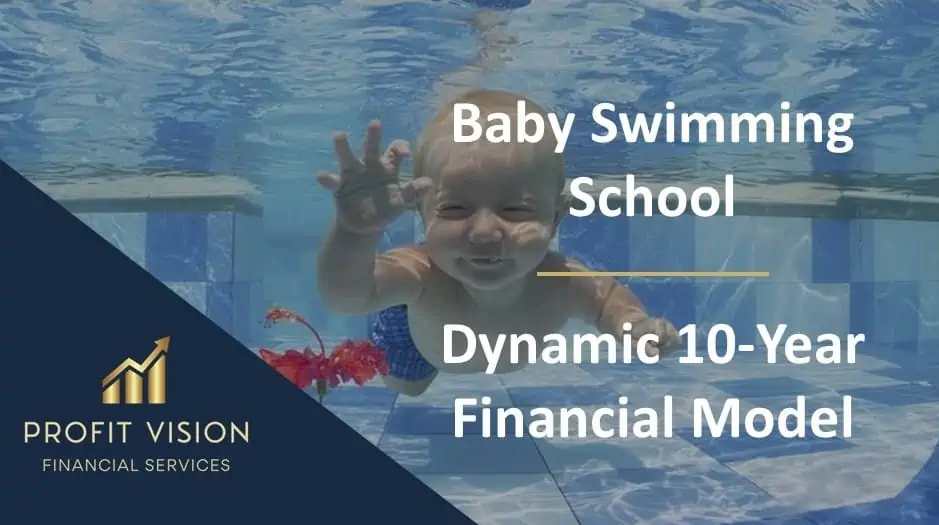Daycare Service Facility Financial Simulation – Up to 10 Year
Dynamic assumptions to create pro forma financial statements for a daycare service facility. Includes an option for terminal value and DCF Analysis.

Video Overview:
This financial feasibility template is good at analyzing the unit economics of a daycare service facility startup. The primary revenue driver is based on capacity assumptions for up to 11 care service types. Each service type is designed to fit a different age group / day count monthly price. This drives the number of accounts at each monthly pricing tier cohort.
Recurring Monthly Pricing Configuration for Each Care Level:
- Seasonality / Capacity – Month 1-12 define percentage of maximum capacity attained.
- Years 2-10 – Define the year-over-year percentage improvement in capacity attained.
- Also, set the maximum stabilized capacity per care level.
- Define the annual increase in monthly fees each year and by each care type.
There are also two other revenue streams: Drop-ins and registration fees. For Drop-ins, the user can define the monthly count of drop-ins for up to two types, for example 2-day per week or 3-day per week. The customer will pay a one-time fee for that and there will be a monthly count of each defined by the user. Registration fees are just based on the monthly tuition customers, and it is based on a percentage of monthly turnover in seat counts.
Direct Costs
The user can enter the expected monthly costs per seat across all eleven care types as well as the cost per drop-ins. These separate schedules make it easy to understand costs at any seat count. The user can define things like monthly cost for diapers per child and monthly cost for food per child. It is important to have these configurable for each care type because the monthly cost for a child getting 2 days a week is going to be different than one that is coming in 5 days a week. The length of time is also important to consider, for example care that is before and after school vs all day care. Each will have different monthly costs.
One new thing about this template is that you won’t find any actual dates in the entire model. Everything is set based on monthly and annual periods for up to 120 months. This is something new I am trying and am looking forward to customer feedback on the usability. So, now instead of defining a launch year and end month, the user simply enters the total number of months the forecast is being run for.
You still have the option to include terminal value or not and there are still fully integrated financial statements (IS/BS/CF) as well as a monthly and annual pro forma detail, DCF Analysis, IRR, and annual Executive Summary along with plenty of visualizations.
To account for other ongoing overheads, the user will be able to enter fixed costs for a wide range of things, including rent, legal fees, utilities, and any sales and marketing costs. Data entry for this involves entering the cost description, the start month number, and the monthly cost (adjustable over 10 years).
I’ve also got a separate section for staffing and on that schedule the user can define up to 32 staff types and for each type is the headcount, starting monthly cost, the start month number, and the annual increase in costs as well as payroll taxes / benefits (editable by staff type).
All Models Bundle:
Get all templates I’ve built in one purchase: https://www.efinancialmodels.com/downloads/all-my-financial-models-spreadsheets-templates-and-tools-120-421052/
Similar Products
Other customers were also interested in...
Online Tutoring Services Financial Model (10+ Yrs ...
The Online Tutoring Services Financial Model is a comprehensive tool designed to analyze the financi... Read more
Driving School – 5 Year Financial Model
Financial Model providing an advanced 5-year financial plan for a startup or operating Driving Schoo... Read more
Sky Diving Center – 5 Year Financial Model
Skydiving is the sport of jumping from an aircraft and performing acrobatic maneuvers in the air dur... Read more
Foreign Languages School – 5 Year Financial Mode...
Financial Model providing an advanced 5-year financial plan for a startup or operating Foreign Langu... Read more
E-Learning Institute Financial Model – Dynamic 1...
Online learning is booming and has become popular among working professionals and students. The enti... Read more
Speech Therapy Center – 5 Year Financial Model
Financial Model providing an advanced 5-year financial plan for a startup or operating Speech Therap... Read more
Start Up Nursery School Financial Model
Start Up Nursery School Financial Model presents the case of an investment in a nursery school and i... Read more
Dance Studio Financial Model – 5 Year Financial ...
Provides an advanced 5-year financial plan for a startup or operating Dance Studio and is a flexible... Read more
E-Learning Marketplace – Dynamic 10 Year Financi...
Financial Model providing a dynamic up to 10-year financial forecast for an E-Learning Marketplace b... Read more
Baby Swimming School – Dynamic 10 Year Financial...
Financial model providing a dynamic 10-Year Financial Plan for a Baby Swimming School for children u... Read more
You must log in to submit a review.































